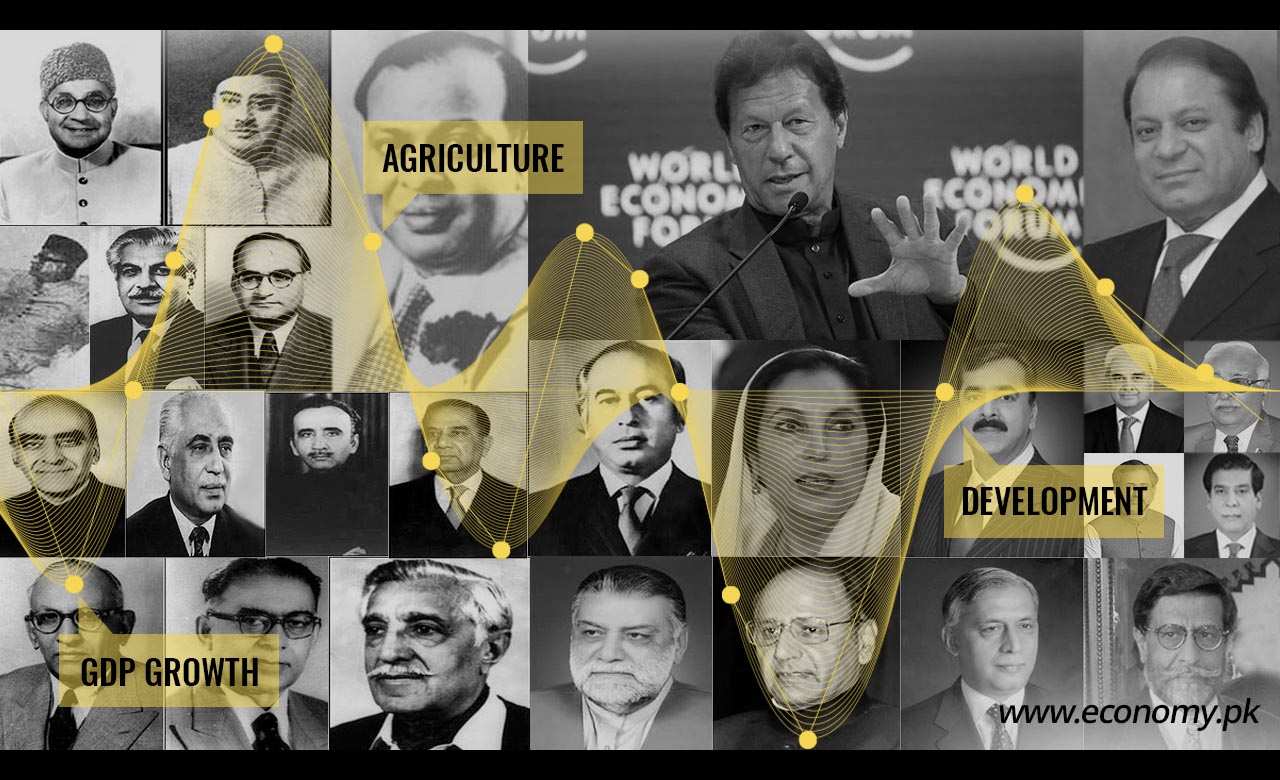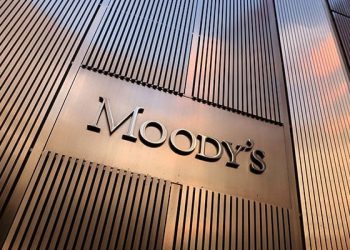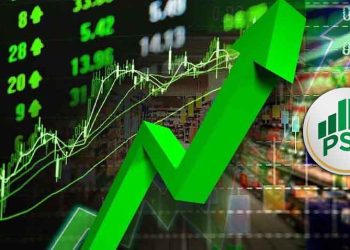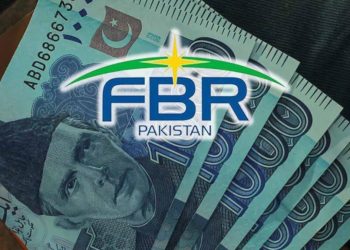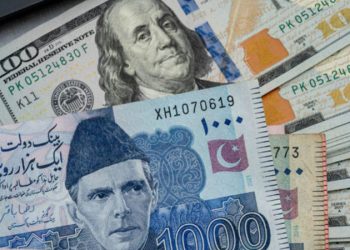14 August 1947 saw the creation of an independent Muslim country called Pakistan. While the struggle for independence was complete, the new country was severely handicapped in economic terms. The country inherited few resources and consisted of an agrarian economy. Thus, from day 1, the economy had to be improved drastically.
1947-1950
The period from 1947-1950 saw minimal economic growth due to the government’s main priority being the drafting of a constitution. There were multiple governments during this period, which saw 3 different people as head of state.
Agriculture share: 53.2%, Change: +0.2%
1950-1958
The period from 1947-1950 saw minimal economic growth due to The 1950s was the decade of planning for an economy transitioning from an agrarian economy to a semi-industrial one. Political instability continued, with 3 people serving as governor-general in a span of 6 years before the post was abolished. Nonetheless, the decade saw progress. The Colombo plan of 1951 was followed by a series of 5-year plans from 1955-1958. A ten-year perspective plan and a 3-year development plan also followed. The Korean war helped boost Pakistan’s exports and the government regulated imports to prevent an excess burden on the economy. All of this resulted in Pakistan’s GDP seeing massive growth.
Agricultural growth: 1.9%
Manufacturing growth: 7.7%
Economic Growth: 3.1%
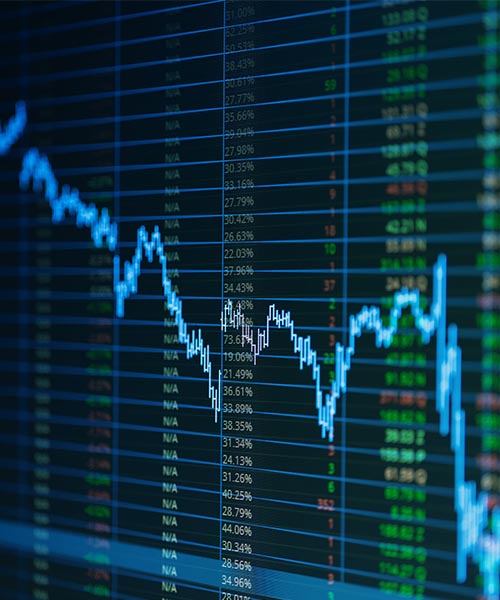
1958-1969
The period from 1947-1950 saw minimal economic growth due to the government’s main priority being the drafting of a constitution. There were multiple governments during this period, which saw 3 different people as head of s1958 saw the rise of Ayub Khan via a military coup. The late ’50s and the majority of the ’60s saw Ayub Khan’s rule. The economy saw huge progress due to political stability.
- The Green Revolution saw agriculture growth at a rate of 5% per annum.
- The first half of the ’60s saw large scale manufacturing grow at a rate of 16% per year, which reduced to 10% after the 1965 war with India.
The GDP grew a lot, with agriculture contributing the most, albeit its influence was reduced due to growth in the industrial sector. Overall, the manufacturing sector grew immensely at a rate unparalleled even today.
GDP growth: 6.7%
Manufacturing growth: 8.51%
1969-1977
The period of 1969-1971 saw 3 different rulers and the separation of the east wing of Pakistan into a new Country-Bangladesh. This was followed by floods, a rise in oil prices, and failures of export crops. The PPP rule of 1971-1977 saw huge losses to the economy.
- Inflation rose to a record 15% and the deficit reached 8% of the GDP.
- The nationalization policy dealt a further blow to the country.
Agricultural growth: 2.7%
Large-Scale Manufacturing Growth: 5.5%
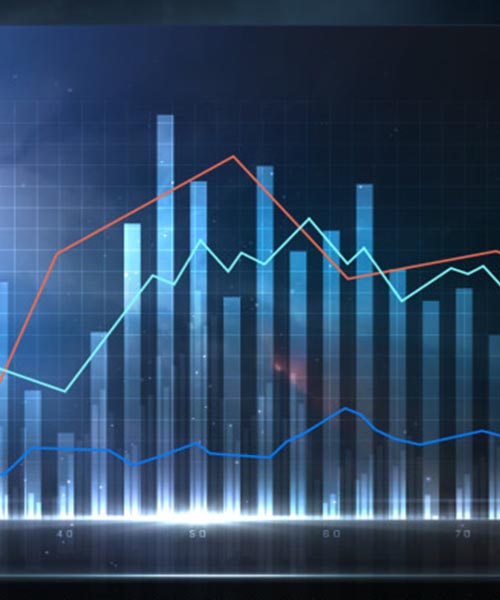
1977-1988
Another military takeover in 1977 saw General Zia take control. He began reversing the PPP’s nationalization scheme. He managed to extract large sums from the United States as an aid for fighting the USSR and used the funds to develop the country. He was further helped by remittances from middle east workers.
- The national savings to GDP ratio rose to 16%.
Agricultural growth: 5.4%
LSM growth: 8.8%
Average GDP growth: 6.3%
1988-1999
General Zia’s death in 1988 saw the return of democracy to Pakistan. However, the ’90s were marred with political instability as the PPP and the PML-N ruled the country. External deficits rose and worker remittances saw a huge decline. Frequent government changes meant that no decisive policies could be made.
- The GDP growth saw its worst increase of only 1.7% in 1996 and the second-worst inflation of 14.5% in 1995.
- Poverty rose, and foreign debt tripled.
- Pakistan’s nuclear program drew further sanctions and left the country on brink of bankruptcy.
Agricultural growth: 4.4%
LSM growth: 4.8%
GDP growth: 4.05%
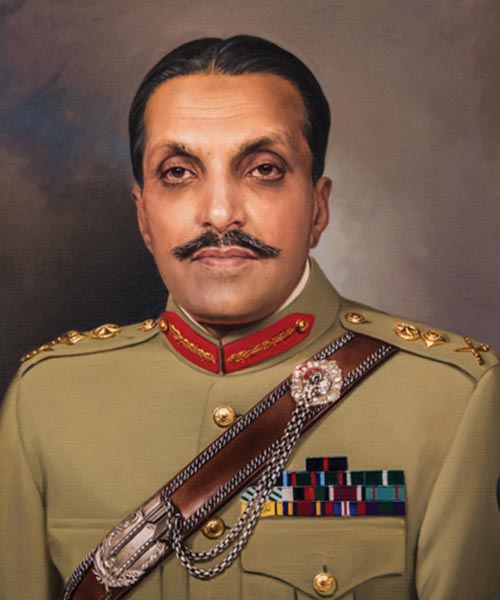
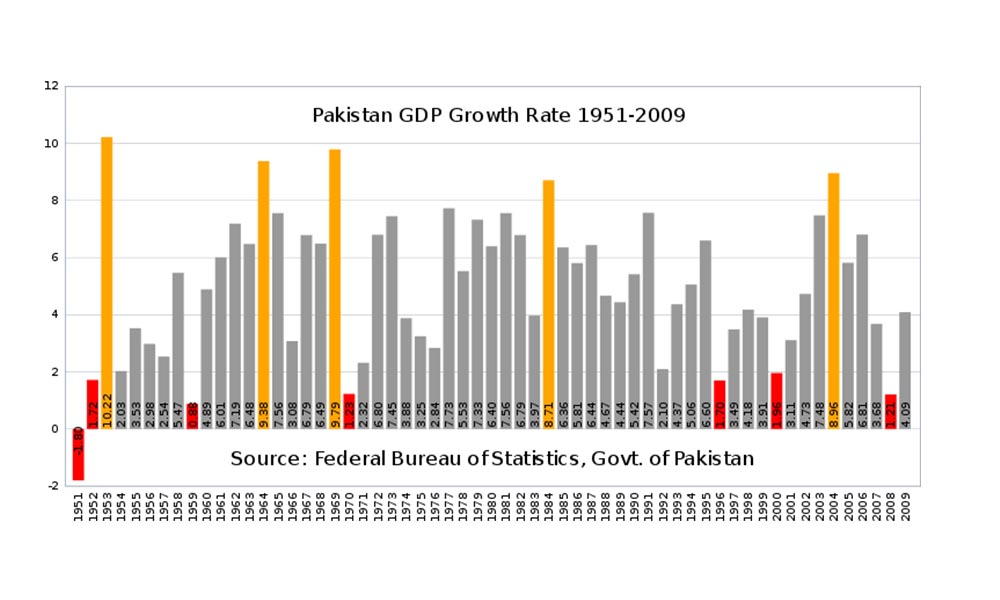
1999-2008
1999 saw the implementation of another martial law. General Pervez Musharraf took the reins this time. The era of General Pervez Musharraf and General Ayub Khan are considered as the golden era’s for the Pakistani Economy. The economy along with the financial status of Pakistan was immensely balanced and a great economical outcome was observed.
- Growth rates saw increases until 2004-2005’s peak of 8.6%.
- Debt to GDP ratio saw a decrease from 100% to 55%.
- Foreign exchange reserves increased by $9 billion.
Agricultural growth: 5.4%
LSM growth: 8.8%
Average GDP growth: 6.3%
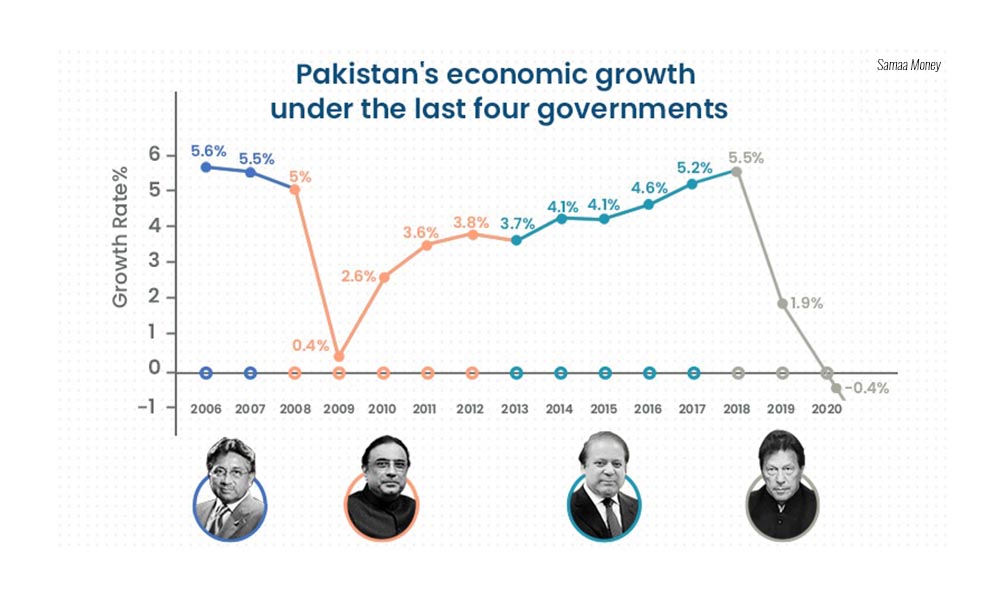
2008-2013
When General Pervez Musharraf resigned, the PPP took control in 2008, and the country once again suffered economically. The growth saw masssive decline either agricultural or overall economical growth.
- Economic growth slowed down to 4.09%, and the yearly growth fell to 2%.
Agricultural growth: 2%
LSM growth: 4.4%
Average growth rate: 4%
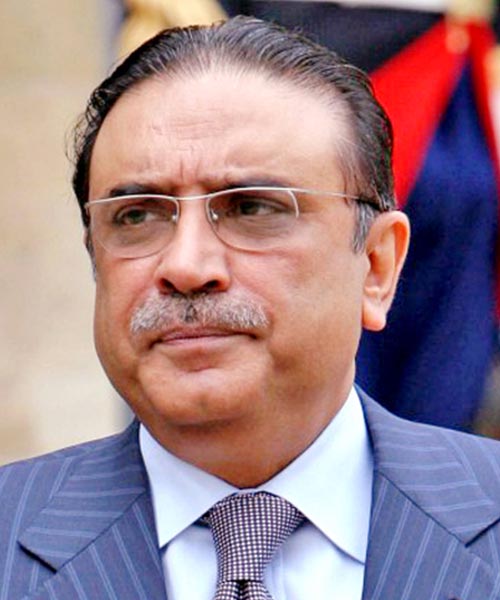
2013-2018
PPP rule continued until 2013, after which the PML-N took charge. The PML-N managed to fix a crippled economy by using IMF loans. GDP growth saw an increase year-on-year and inflation dropped for most of their rule. Macro-economic stability ensued and Moody’s declared Pakistan’s economy stable.
- Average GDP growth rate: 5%
2018-2020
In 2018, the PTI was elected for the first time. Prime Minister Imran Khan was confident that his party will bring all the statistical success for the Pakistani Economy. However, the party introduced various economic reforms that had the wrong effect.
- GDP growth rate fell to a historic low of 0.99% in 2019, much below the 5.55% in 2017.
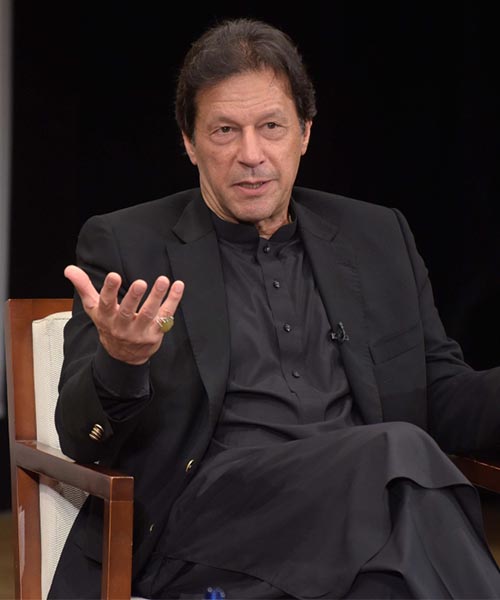
Furthermore, macroeconomic stability had diminished as the government added $70 billion in loans to the already existing debt. The economic situation has been worsened in 2020 by the coronavirus pandemic, which has erased millions of jobs and plunged the country into a deep crisis. Analysts have expected low growths in every sector.
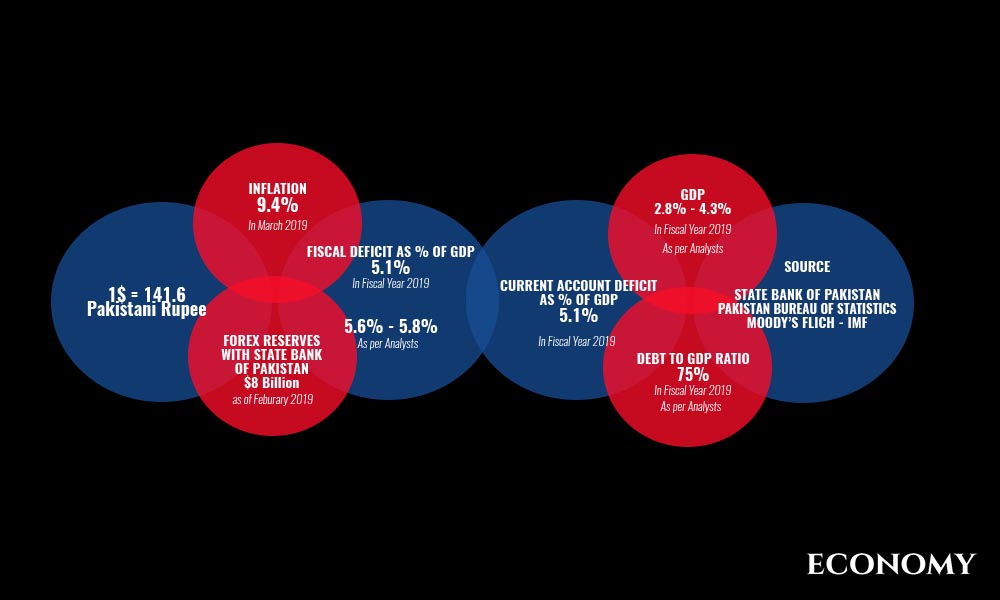
Despite the various challenges, Pakistan has progressed a lot. The country managed to become a semi-industrial one and a hub for business activity.
Changes in GDP proportions 1947-2019
Sector
Agriculture
Industry
Services
1947
53%
9.6%
37.2%
2019
22.04%
18.34%
53.86%
Change – Percentage
Negetive – -30.96% (Minus)
Positive – +8.74% (Plus)
Positive – +16.66% (Plus)
